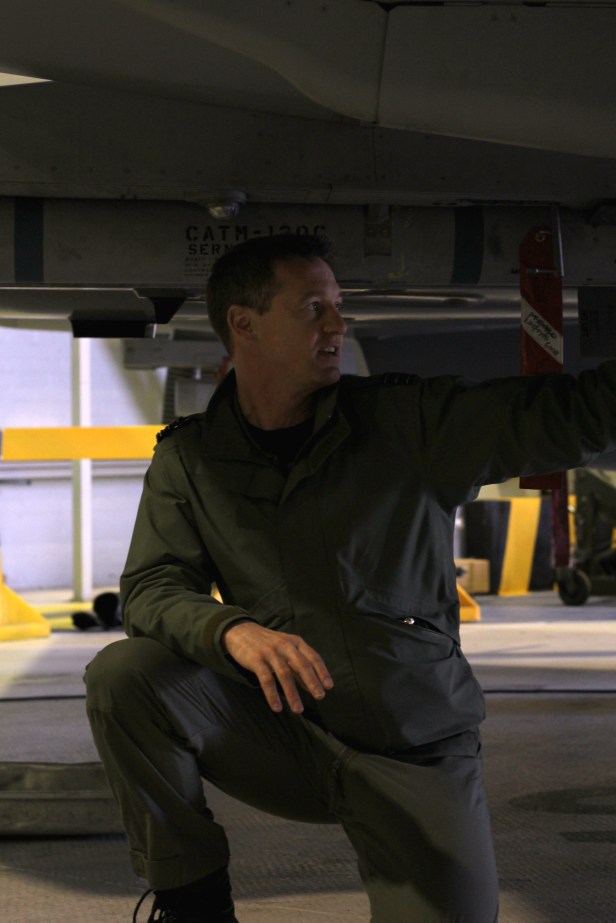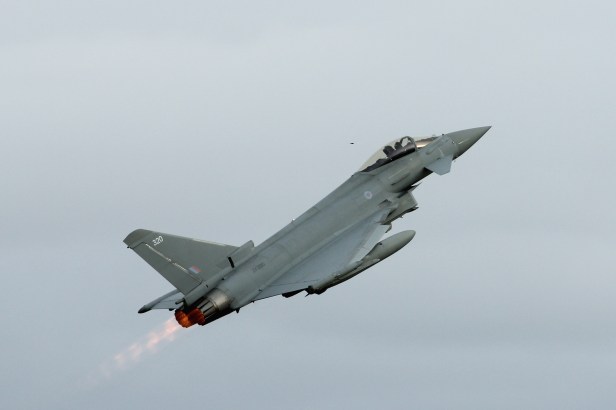The Eurofighter Typhoon is probably the most misunderstood aircraft of the HX program. The public perception of it, especially outside of Finland, is surprisingly negative. Much of this is based on the early teething troubles experienced by the program. “There were absolutely issues to starts with”, group captain Paul Godfrey, OBE, concedes. The former Harrier pilot is the station commander of RAF Lossiemouth, the larger of Britain’s two Typhoon-bases, and one of the original pilots to transition to the multirole fighter when it first entered service with the RAF a decade ago, something he was chosen for partly because he had multirole experience from flying the F-16CJ ‘Wild Weasel’-variant during an exchange tour with the USAF. Of his current mount, he has (almost) nothing but praise. “It’s like an F-16 on steroids”, he compares the two, talking about the similar philosophy of the aircrafts, with both focusing on performance and multirole capability. Fully coming to grip with the multirole tasking has required some new thinking for the RAF, who up until recently operated a large variety of single-role aircraft. This was one of the reasons pilots with exchange experience were common in the first Typhoon units. Today, there’s naturally a considerable number of ex-single role pilots, especially as the Tornado is approaching the end of it’s service life in the RAF.

“When I first flew Typhoon, I knew it was gonna be a game changer.”
Group Captain Paul Godfrey OBE, Station Commander at RAF Lossiremouth
But while the early Typhoons were plagued by a number of different issues and a decided lack of interest on the part of British politicians when it came to funding the necessary development programs needed to unlock the fighters full potential, today it is in many ways a mature system. This was something Godfrey got to experience first hand. Only in the second week of his new job as station commander, he was faced with the order to dispatch six Typhoons from 1(F) Squadron down to RAF Akrotiri in Cyprus, from where they were to conduct strikes over Iraq and Syria. Within twenty-four hours of receiving the mission, the Typhoons touched down at their new operating base, and within a further twenty-four hours the first combat-loaded aircrafts were already flying operational missions over the battlefield. After 1(F) Squadron was ready with their tour, fellow Lossiemouth squadron 6 Squadron took over. In total, Lossiemouth based Typhoons alone have dropped closed to 700 Paveway IV laser/GPS-guided bombs during Operation Shader, as the British anti-ISIL air operation is known.
The missions flown in Syria and Iraq include air interdiction, close air support (CAS), and strike coordination and reconnaissance (SCAR). Cue lasting debate over value of fast jets as opposed to classic single-role aircraft such as the A-10 Warthog or Su-25 flying the CAS mission. For wing Commander Billy Cooper, the squadron commander of 6 Squadron, the answer is clear. The old way of doing CAS was created out of necessity, as the only way of acquiring a target accurately was by looking out of the window, which meant you had to be close to the target and flying slow. With today’s advanced sensors and precision guided munitions, that need is gone, and using faster and more advanced aircraft will provide significant benefits, including e.g. survivability and transit time from loitering area to the battlefield. Originally a Tornado F.3 pilot, Cooper is also a Qualified Weapons Instructor with over 3,000 flying hours on fighters. The RAF QWI course roughly corresponds to the US Navy’s TOPGUN program, but strives to give a broader understanding of the aircraft, it’s weapons and capabilities. Earlier this year, he lead the squadron in exercise Red Flag 17-1 in Nevada, an exercise which created quite some buzz for being the first time the F-35A participated in a Red Flag exercise.

“We were working quite closely with the F-35.”
Wing Commander Billy Cooper, Officer Commanding 6 Squadron
While it was heavily reported that the F-35A had achieved a 20:1 kill ratio, the details of the exercise has naturally been kept under wraps. As such, it was very interesting to hear Cooper describe his first-hand experience of operating Typhoons together with the F-35’s. As could be expected, he described the F-35 regularly operating within the engagement zones of the REDFOR air defences. Compared to other non-stealthy fighters, the Typhoon was in turn able to achieve greater stand-off range for its weapons, thanks to its ability to operate higher and faster. This allowed it to lay further back, often remaining outside of the threat range. What all seemed to agree on, was that the the F-35 transmitting sensor data on Link 16 provided a huge boost in situational awareness for the rest of the fleet.
When asked about the RAF acquiring both aircraft, none of the pilots were prepared to pick one over the other. “You need stealth to be able to go forward,” Cooper argued. His personal opinion was that the future lies in the mix of capabilities provided by different platforms, echoing the sentiment expressed by his commander at an earlier briefing. “Both airplanes are fantastic airplanes,” Godfrey had said. “A mix would always be better [than operating only F-35’s or Typhoons].” When pressed further for which one he would choose if he could only get one, Godfrey had smiled and just said “Both”.
While a puzzled group of Finnish media representatives started to wonder if the fighter pilots were arguing for the stealthy F-35 as the right choice for HX, further discussion revealed the complexity of the issue. The big thing in the mind of the pilots was not so much stealth in and by itself, but the superior situational awareness the F-35 got by combining the ability to get in close while carrying a good sensor suite, and which it then shared with the rest of the team. By teaming up with the Typhoons and their heavy load of long-ranged weapons, the F-35 in turn got around it’s main weakness in Red Flag, namely its very limited load of internal weapons. Some participants in the exercise jokingly referred to the stealth fighter as the ‘cheerleader’, always present providing data and cheering the other ones on, but often unable to take the shots themselves having already expended all their missiles.
It also seemed that for an air force used to operating a wide variety of tactical single-role jets the Finnish problem of only being able to afford a single type while not being able to count on the support of allies was hard to relate to. BAE test pilot Paul Smith, a former squadron mate of Cooper, agreed with the operational pilots that he saw a future need for a stealthy platform providing increased situational awareness, but rather than going for a stealth fighter he talked about replicating the successful hunter/killer-teams of Red Flag with an unmanned stealthy wingman getting in close and the Typhoon bringing its firepower to bear from stand-off range (yes, a picture of Taranis had managed to sneak its way into one of the briefings).
But while going into heavily defended airspace with a non-stealthy platform might not be optimal, Red Flag did also see the Typhoon do just that and come out on the other side to live to tell the tale. While the exact details aren’t open information, we were briefed that the fighters took out targets being covered by layered defences of “double and triple digit SAM’s”, indicating systems entering service in the early 80’s and later, likely including at least the S-300. What made this possible was two things. To begin with, the Typhoon’s self-defence DASS suite received nothing but praise. The system not only automatically scans for threats and autonomously uses jamming and countermeasures to defeat them, it also provide visual cues for the pilot on how to best outmanoeuvre any threats encountered. The other factor that increased the survivability of the Typhoon was again its performance. The combination of a manoeuvrable aircraft with an impressive thrust-to-weight ratio gave the pilots the ability to defeat the missiles encountered. It might not be as nice as having stealth, but BAE puts enough trust in the concept to plan for the upcoming P4E enhancement to include a SEAD/DEAD-ability (more on the upgrade path in an upcoming post).
In the end, no-one was willing to tell us which aircraft we were supposed to buy, though for the RAF, the operational concept is clear. Typhoon is set to stay the force’s air superiority platform past 2050, while “F-35 is a Tornado [GR.4] replacement,” as BAE’s John Bromehead explained. None of the pilots seemed interested in trading their Typhoons for F-35’s, but they just might be willing to swap out the Typhoons of the squadron next door.

“I’ll never gonna give up speed”
Gp Capt Godfrey


Very interesting! Good article, cheers
Thank you! More posts from RAF Lossiemouth to follow next week.
I particularly liked the comment that Typhoon pilots would not be willing to give up their aircraft for the F-35 – swapping the Typhoons of the squadron next door, however…! What’s your take on the F-35B? Will it be able to fill the “cheerleader” role as well as the F-35A?
The range will be shorter, but other than that it should be able to do it just as well. It obviously depends on the situation how much of a difference the smaller range does, over the North Sea it will be an issue, in other places not so much.
One comment on “cheerleading”, it should be remembered that F-35A’s flying in the red flag were Block 3I, which means they were cleared to carry only 2 AMRAAMs internally, while Block 3F will allow them to carry 4.
That’s certainly a valid point! Makes quite a difference.
Also the F-35 will eventually be able to carry 6 amraams internally, don’t remember which Block will get this ability.
Hyvä teksti!
t. Pentti Perttula
Kiitos! Hyvää jos muut jotka kuuntelivat samaa briefingiä ovat samaa mieltä siitä mistä puhuttiin 😉
There is nothing stopping an operator increasing the f-35 weapons load by carrying external weapons… Yes, it makes the F-35 more detectable, but so is the Typhoon in these scenarios and it still delivers needed capability…
In Block 3F, 4x internal AMRAAMS can be carried. Externals weapons could see up to 4 more AMRAAM carried, alomg with a pair of external IR missiles (ASRAAM, AIM-9X) if all that is important is increased missile loads… Later development will see MER’s developed for F-35 pylons and then the Typhoon won’t even have it’s load capacity advantage to fall back on…
The F-35 will get larger payloads, that’s for sure, but I found your notion that the F-35 would get a stream of upgrades while the Typhoon basically stands still a bit strange. What is certain is that for any given load condition (internal or external), the F-35 will sport a lower RCS while the Typhoon will have better performance. That’s just the natural outcome of two very different design philosophies.